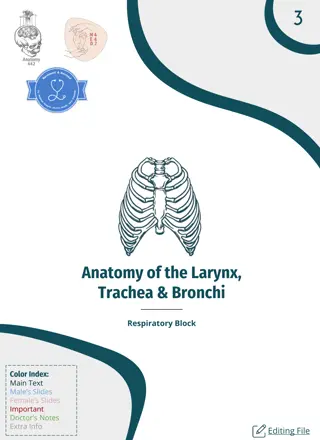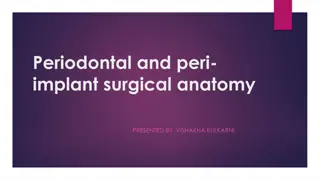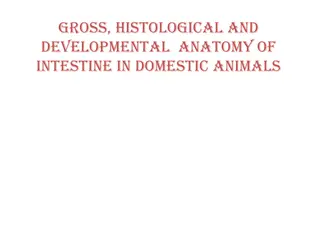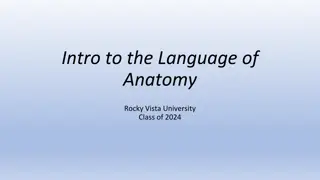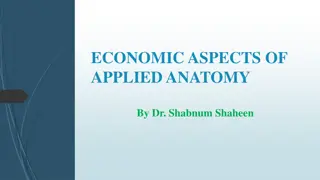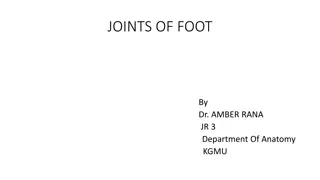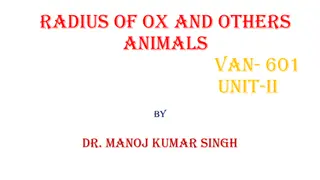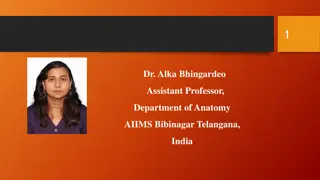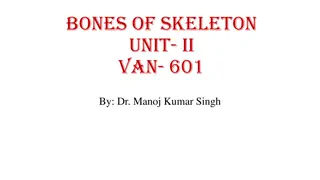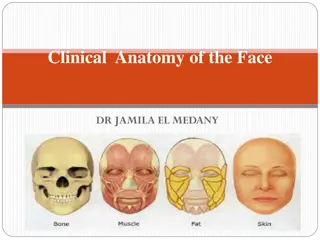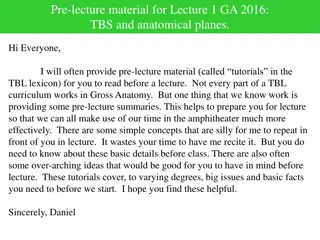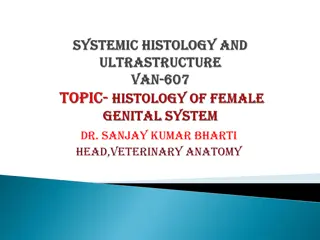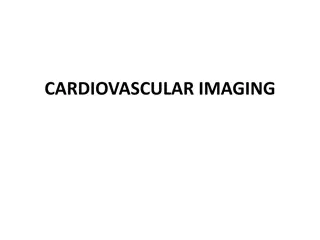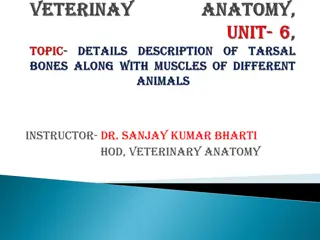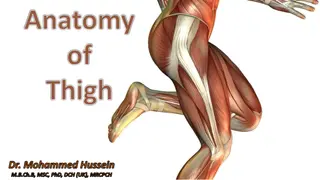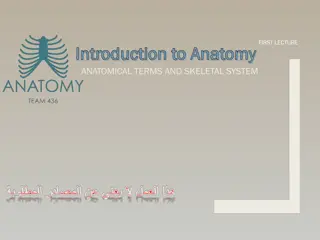و یموتانآ یژولویزیف
Understanding the basic anatomy and physiology of the respiratory system is crucial for comprehending the processes involved in breathing. The upper airway humidifies inhaled gases and serves as the site of most resistance to airflow. The lower airway consists of conducting airways and alveoli for gas exchange. In terms of physiology, a negative pressure circuit exists to maintain alveolar open, overcome resistance, and balance elastic recoil forces of the chest wall and lungs. Ventilation involves the regulation of carbon dioxide levels and effective tidal volume. Additionally, respiration encompasses internal and external processes related to gas exchange in alveoli. Explore the dynamics of respiration, ventilation, and gas exchange in this comprehensive guide.
Download Presentation

Please find below an Image/Link to download the presentation.
The content on the website is provided AS IS for your information and personal use only. It may not be sold, licensed, or shared on other websites without obtaining consent from the author.If you encounter any issues during the download, it is possible that the publisher has removed the file from their server.
You are allowed to download the files provided on this website for personal or commercial use, subject to the condition that they are used lawfully. All files are the property of their respective owners.
The content on the website is provided AS IS for your information and personal use only. It may not be sold, licensed, or shared on other websites without obtaining consent from the author.
E N D
Presentation Transcript
Basic Anatomy Upper Airway humidifies inhaled gases site of most resistance to airflow Lower Airway conducting airways (anatomic dead space) respiratory bronchioles and alveoli (gas exchange)
Basic Physiology Negative pressure circuit Gradient between mouth and pleural space is the driving pressure need to overcome resistance maintain alveolus open overcome elastic recoil forces Balance between elastic recoil of chest wall and the lung
Basic Physiology http://www.biology.eku.edu/RITCHISO/301notes6.htm
Ventilation Carbon Dioxide PaCO2= k * alveolar minute ventilation metabolic production Alveolar MV = resp. rate * effective tidal vol. Effective TV = TV - dead space Dead Space = anatomic + physiologic
PHYSIOLOGY Respiration Ventilation: air entering and leaving the alveoli. Transfer through the alveolo- capillary membrane: exchange of O2 and CO2 between the blood in the capillaries and the gases in the alveoli. Perfusion - Circulation: transfer of O2 from the pulmonary capillaries to the cells of the body and transfer of CO2 from the cells to the pulmonary capillaries. Cellularrespiration: transfer of O2 in the blood to the cells and CO2 from the cells to the blood.
Alveolar/capillary membrane Capillary Alveolus O2 O2 O2 O2 O2 CO2 O2 O2 O2 O2 O2 O2 O2 O2 O2 O2 CO2 CO2 O2 CO2 O2 O2 O2 CO2 CO2 CO2 CO2 O2 O2 O2 O2 O2 O2 O2 O2 O2 O2 O2 O2 O2 CO2 CO2 CO2 O2 O2 CO2 CO2 CO2 Membrane
Oxygenation Oxygen: Minute ventilation is the amount of fresh gas delivered to the alveolus Partial pressure of oxygen in alveolus (PAO2) is the driving pressure for gas exchange across the alveolar-capillary barrier PAO2 = ({Atmospheric pressure - water vapor}*FiO2) - PaCO2 / RQ Match perfusion to alveoli that are well ventilated Hemoglobin is fully saturated 1/3 of the way thru the capillary
The alveolus PalvCO2 = Palv e.g. 5 % x 760 = 38 mm Hg % CO2 x PalvO2 = e.g. 13.3 % x 760 = 101 mm Hg e.g. 50 % x 760 = 380 mm Hg e.g. 50 % x (760 + 25) = 393 mm Hg (25 mm Hg = 33 cm H2O) % O2 x PALV PalvCO= 5 % x 760 = 38 mm Hg PalvO2 = 45 % x 760 = 342 mm Hg PalvN = 50 % x 760
Gaseous exchange Partial oxygen pressures in the blood % SAT O2 xx O2 O2-Hb- O2 O2 O2 O2 O2 O2 O2 O2-Hb- O2 O2 O2-Hb- O2 O2 O2 O2 PaO2 Fixed and dissolved oxygen Oxygen dissociation curve
Oxygenation http://www.biology.eku.edu/RITCHISO/301notes6.htm
Gaseous exchange Hemoglobin dissociation curve 100 20 16 80 Veinous PO2 = 40 Arterial PO2 = 100 HEMOGLOBIN SATURATION O2 CONTENT IN ml/100ml Sat = 75 Sat = 97 12 60 8 40 4 20 0 20 40 PO2 mm Hg 60 80 100
Gaseous exchange Correspondence between PaO2 and SaO2 at normal pH PaO2 mm Hg SaO2 % 96-105 86-95 76-85 66-75 56-65 46-55 35-45 98 97 95 93 89 84 75
Gaseous exchange Oxygen transfer PO2 kPa 1 mmHg = 1,359 cmH2O 1 cmH2O = 0,735 mmHg 1 hPa = 1 cmH2O = 1 mbar AIR INHALED 20.9 Alveoli ALVEOLAR GAS 13.3 O2 10.0 ARTERIEL BLOOD O2 O2 O2 O2 O2 VEINOUS BLOOD 5.3 2.7 O2 O2 TISSUE Cells
Gaseous exchange Transfer of carbon dioxide PCO2 kPa Tissue 6.7 TISSUE CO2 VEINOUS BLOOD ARTERIAL BLOOD 6.1 5.3 CO2 CO2 CO2 2.7 EXHALED AIR Alveoli CO2
Abnormal Gas Exchange Hypoxemia can be due to: hypoventilation V/Q mismatch shunt diffusion impairments Hypercarbia can be due to: hypoventilation V/Q mismatch Due to differences between oxygen and CO2 in their solubility and respective disassociation curves, shunt and diffusion impairments do not result in hypercarbia
Gas Exchange Hypoventilation and V/Q mismatch are the most common causes of abnormal gas exchange in the PICU Can correct hypoventilation by increasing minute ventilation Can correct V/Q mismatch by increasing amount of lung that is ventilated or by improving perfusion to those areas that are ventilated
Mechanical Ventilation What we can manipulate Minute Ventilation (increase respiratory rate, tidal volume) Pressure Gradient = A-a equation (increase atmospheric pressure, FiO2, increase ventilation, change RQ) Surface Area = volume of lungs available for ventilation (increase volume by increasing airway pressure, i.e., mean airway pressure) Solubility = ?perflurocarbons?
Compliance ) ( .
Mechanical Ventilation If volume is set, pressure varies ..if pressure is set, volume varies .. .according to the compliance ... COMPLIANCE= Volume / Pressure
Compliance Burton SL & Hubmayr RD: Determinants of Patient-Ventilator Interactions: Bedside Waveform Analysis, in Tobin MJ (ed): Principles & Practice of Intensive Care Monitoring
Resistance ) (: .
: VT : Tidal volume 6 - 8 ML/Kg ML . ) ( 500 .
IC : Inspiratory capacity=VT+IRV) (FRC : Functional Residual Capacity=ERV+RV) (VC = Vital Capacitity)= IRV+VT+ERV)


